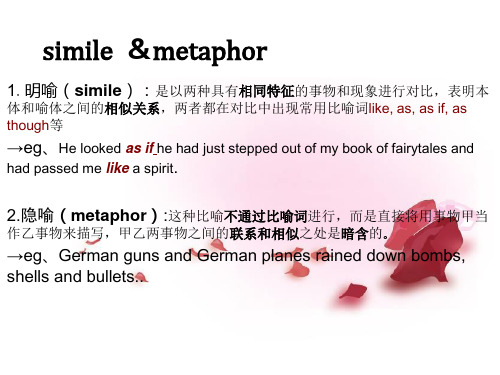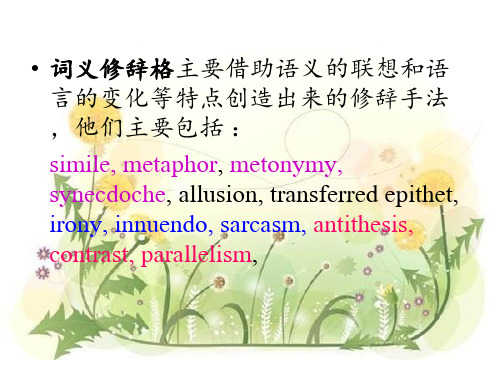《英语修辞格》.ppt
合集下载
英语修辞格 ppt

Thank You!
假设你准备郊游,并且期待天气会很好,但是那天却下大雨。如 果你丌说天气糟透了,而说“what fig!”
那就是用反语了。
讽刺(Sarcasm)
It Sarcasm is a strong form of irony. It attacks in a taunting and bitter manner, and its aim is to disparage, ridicule and wound the feelings of the subject attacked.
laws are like cobwebs, which may catch small flies, but let wasps break through
Well, of course, I knew that gentlemen like you carry only large notes.
1.The Great Wall was made not only of stones and earth, but of the flesh and blood of millions of men. 句中的“the flesh and blood”喻为“the great sacrifice”(巨大的 牺牲) 2.“...saying that it was the most beautiful tongue in the world,...” 这里用具体的“tongue”代替抽象的“language”。
It is a figure of speech that achieves emphasis by saying the opposite of what is meant, the intended meaning of the words being the opposite of their usual sense.
修辞格与翻译PPT课件

❖As close as an oyster 守口如瓶
❖As sure as a gun
千真万确
❖As cool as a cucumber 泰然自若
❖As mute as a fish
噤若寒蝉
❖As blue as the great sea
2021/3/7
10
CHENLI
❖(3) as if; as though
❖ 婚姻像是一个被包围的城堡:外边的想要进去,里边的想 要出来。
2021/3/7
8
CHENLI
❖(2) as
❖As the lion is king of beasts, so is the eagle king of birds.
❖鹰是鸟中之王,犹如狮是兽中之王。
❖Love goes towards love, as schoolboys from their books;
2021/3/7
16
CHENLI
❖The pain of separation ❖The light of learning ❖A vicious circle ❖Room for negotiation ❖An angry sky ❖Graves yawned ❖Killing half-an-hour ❖Shoulder of the hill 山脊 ❖Friendly river ❖Laughing valleys
2
CHENLI
❖Rhetoric 修辞学
❖Rhetoric is the art of discourse, an art that
aims to improve the capability of writers or speakers that attempt to inform, persuade, or motivate particular audiences in specific
英语修辞手法PPT课件

11
Metaphor
• A simile is different from an ordinary, literal comparison.
– Jim looks like his brother Billy. ×
10
Metaphor
• It is like a simile, also makes a comparison between two unlike elements, but unlike a simile, this comparison is implied rather than stated.
9
Simile
• The world is like a stage. • Jim was as cunning as a fox.
• Words in a dictionary are like objects in a museum; They are interesting but merely on display. When words are used in communication, they come to life and go to work for us.
sense because life does not have any
color.
5
• There are syntactic devices, lexical devices, phonetic devices.
• 句法 • 词汇 • 音韵
6
Rhetorical Devices
• There are quite a number of rhetorical devices. Each device has its own form and characteristics, and its own way of achieving effect. Sometimes two or more devices can be used together for greater impact.
Metaphor
• A simile is different from an ordinary, literal comparison.
– Jim looks like his brother Billy. ×
10
Metaphor
• It is like a simile, also makes a comparison between two unlike elements, but unlike a simile, this comparison is implied rather than stated.
9
Simile
• The world is like a stage. • Jim was as cunning as a fox.
• Words in a dictionary are like objects in a museum; They are interesting but merely on display. When words are used in communication, they come to life and go to work for us.
sense because life does not have any
color.
5
• There are syntactic devices, lexical devices, phonetic devices.
• 句法 • 词汇 • 音韵
6
Rhetorical Devices
• There are quite a number of rhetorical devices. Each device has its own form and characteristics, and its own way of achieving effect. Sometimes two or more devices can be used together for greater impact.
英语修辞 Microsoft PowerPoint 演示文稿

Personification 拟人
• • • 拟人是把生命赋予无生命的事物. 例如: 1>.The night gently lays her hand at our fevered heads.(把夜拟人化) • 2>.I was very happy and could hear the birds singing in the woods.(把鸟拟人 化)
Metonymy 借喻,转喻
• • • • • • • • • 借喻不直接说出所要说的事物,而使用另一个 与之相关的事物名称. I.以容器代替内容,例如: 1>.The kettle boils. 水开了. 2>.The room sat silent. 全屋人安静地坐着. II.以资料.工具代替事物的名称,例如: Lend me your ears, please. 请听我说. III.以作者代替作品,例如: a complete Shakespeare 莎士比亚全集
通ቤተ መጻሕፍቲ ባይዱ(synesthesia)
• 通感(synesthesia)是指在某个感官所产生的感觉,转到 另一个感官的心理感受。 Some books are to be tasted, others to be swallowed and some few to be chewed and digested. 有些书是应当尝尝滋味的,有些书是应当吞下去的,有少 数书是应当咀嚼和消化的。 书是“尝”不出味道的,也是不能“吃”下去将其“消化” 掉的。这里把读书中的精读和泛读,阅读欣赏与吸收知识 的感受,用味觉功能和消化功能来表示,心理感受是如此 逼真和奇特。
• Like climbing a mountain, we struggle up three feet and fall back two.(正如爬山, 我们费力爬上三英尺,又掉下去两英尺。) •
英语修辞手法及练习ppt课件

→eg.My only worry was that January would find me hunting for a job
again.
病原体侵入机体,消弱机体防御机能 ,破坏 机体内 环境的 相对稳 定性, 且在一 定部位 生长繁 殖,引 起不同 程度的 病理生 理过程
Pun & Parody & Oxymoron
ironysy & nesthesia &personification
• 7.讽刺(irony):用含蓄的褒义词语来表示其反面的意义,从而达
到使本义更加幽默,更加讽刺的效果。
→eg .It would be a fine thing indeed not knowing what time it was in
→eg.Iam sorry, I am so sorry, I am so extremely sorry.
• 15、拟声(onomatopoeia)是摹仿自然界中非语言的声音,其发音和所描写
的事物的声音很相似,使语言显得生动,富有表现力。
→eg .She banged the door after her.
• 10.双关语(pun)是以一个词或词组,用巧妙的办法同时把互不关
联的两种含义结合起来,以取得一种诙谐有趣的效果。
→eg .Napoleon was astonished.”Either you are mad, or I am,”he
declared. “Both,sir!”cried the Swede proudly.
.
病原体侵入机体,消弱机体防御机能 ,破坏 机体内 环境的 相对稳 定性, 且在一 定部位 生长繁 殖,引 起不同 程度的 病理生 理过程
• 6.She may have tens of thousand of babies in one summer.(from“ Watching Ants”)。(persnification)
again.
病原体侵入机体,消弱机体防御机能 ,破坏 机体内 环境的 相对稳 定性, 且在一 定部位 生长繁 殖,引 起不同 程度的 病理生 理过程
Pun & Parody & Oxymoron
ironysy & nesthesia &personification
• 7.讽刺(irony):用含蓄的褒义词语来表示其反面的意义,从而达
到使本义更加幽默,更加讽刺的效果。
→eg .It would be a fine thing indeed not knowing what time it was in
→eg.Iam sorry, I am so sorry, I am so extremely sorry.
• 15、拟声(onomatopoeia)是摹仿自然界中非语言的声音,其发音和所描写
的事物的声音很相似,使语言显得生动,富有表现力。
→eg .She banged the door after her.
• 10.双关语(pun)是以一个词或词组,用巧妙的办法同时把互不关
联的两种含义结合起来,以取得一种诙谐有趣的效果。
→eg .Napoleon was astonished.”Either you are mad, or I am,”he
declared. “Both,sir!”cried the Swede proudly.
.
病原体侵入机体,消弱机体防御机能 ,破坏 机体内 环境的 相对稳 定性, 且在一 定部位 生长繁 殖,引 起不同 程度的 病理生 理过程
• 6.She may have tens of thousand of babies in one summer.(from“ Watching Ants”)。(persnification)
英语修辞格译法ppt课件

United we stand, divided we fall. 合则存,分则亡。
20
(三)句式修辞格(syntactical rhetorical devices)
句子结构上的修辞格主要是指通过句子结构的 布局或变化来达到一定的修辞手法。这类辞格 主要包括 repetition反复, rhetorical question设问, antithesis对偶, apostrophe倒装,parallelism排比, climax层递 等。例如:
(转喻),transferred epithet(转移修饰),
personification(拟人), hyperbole(夸张),
irony(反语), euphemism(委婉语), pun(双
关), oxymoron(矛盾修辞法), zeugma(轭式
搭配法), contrast (对照)等。
8
(1)The baby was brought up on the bottle.
这个婴儿是喝牛奶或羊奶长大的。(metonymy── 用奶瓶代奶)
(2)Some mute inglorious Milton here may rest.
某个沉默的、无名诗人也许在此长眠。
(antonomasia──用米尔顿代诗人)
6
Assonance是在一句话或在一个诗行中间,有两 个或更多的词具有相同的元音。例如:
With this faith we will be able to hew out of the mountain of despair a stone of hope. 怀着这个信念,我们能把绝望的大山凿成希望 的磐石。
sweet sorrow 忧喜参半 (不是甜蜜的悲伤); proud humility 不卑不亢 (不是骄傲的谦卑)
20
(三)句式修辞格(syntactical rhetorical devices)
句子结构上的修辞格主要是指通过句子结构的 布局或变化来达到一定的修辞手法。这类辞格 主要包括 repetition反复, rhetorical question设问, antithesis对偶, apostrophe倒装,parallelism排比, climax层递 等。例如:
(转喻),transferred epithet(转移修饰),
personification(拟人), hyperbole(夸张),
irony(反语), euphemism(委婉语), pun(双
关), oxymoron(矛盾修辞法), zeugma(轭式
搭配法), contrast (对照)等。
8
(1)The baby was brought up on the bottle.
这个婴儿是喝牛奶或羊奶长大的。(metonymy── 用奶瓶代奶)
(2)Some mute inglorious Milton here may rest.
某个沉默的、无名诗人也许在此长眠。
(antonomasia──用米尔顿代诗人)
6
Assonance是在一句话或在一个诗行中间,有两 个或更多的词具有相同的元音。例如:
With this faith we will be able to hew out of the mountain of despair a stone of hope. 怀着这个信念,我们能把绝望的大山凿成希望 的磐石。
sweet sorrow 忧喜参半 (不是甜蜜的悲伤); proud humility 不卑不亢 (不是骄傲的谦卑)
英语修辞ppt

• 文中分别用every head和quick hands喻指小时候居里夫 人和她那班小女孩知道沙俄督学马上要进教室检查时,既 害怕却又镇静地藏好波兰历史书。作者使用提喻,描写十 分生动,读者看了犹如身临其境。
1. head
人体主要部位头head用于提喻可以代表各种各样的忍, 非常生动,例如:a hot head ,
• 以此引发读者联想和想象, • 并使语言文采斐然,富有很强的感染
力。 • 使语言生动形象,还可以使深刻的、
抽象的道理浅显、具体地表达出来。
Synecdoche(提喻)
Definition: It involves the substitution
of the part for the whole, or the whole for the part.
• He earned his bread as a teacher. 他以教 书为生。
• Living (“面包”指代抽象名词“生计” )
• The wolf and the pig mingled together in his face.他的脸上带着凶残和贪婪的神色
• Fierceness greediness • 用“狼”指代其“凶残的”本性,用“猪
• 例2:Two heads are better than one.两个脑袋总比一个脑袋强 。
• 用人体部位“头”指代整体“人”。提喻
• 例5:He has an old head on young shoulders.他年轻而有见识 。
• Head 是人体部位,前面加了形容词old后,产生一种联想意义 ,即“有见识的”;shoulders也是人体部位,前面加了形容词 young 后,产生一种象征意义,即“年轻人”。该句没有用人 体部位指代整体,而是用人体部位指代其特点,故修辞手法 是转喻
1. head
人体主要部位头head用于提喻可以代表各种各样的忍, 非常生动,例如:a hot head ,
• 以此引发读者联想和想象, • 并使语言文采斐然,富有很强的感染
力。 • 使语言生动形象,还可以使深刻的、
抽象的道理浅显、具体地表达出来。
Synecdoche(提喻)
Definition: It involves the substitution
of the part for the whole, or the whole for the part.
• He earned his bread as a teacher. 他以教 书为生。
• Living (“面包”指代抽象名词“生计” )
• The wolf and the pig mingled together in his face.他的脸上带着凶残和贪婪的神色
• Fierceness greediness • 用“狼”指代其“凶残的”本性,用“猪
• 例2:Two heads are better than one.两个脑袋总比一个脑袋强 。
• 用人体部位“头”指代整体“人”。提喻
• 例5:He has an old head on young shoulders.他年轻而有见识 。
• Head 是人体部位,前面加了形容词old后,产生一种联想意义 ,即“有见识的”;shoulders也是人体部位,前面加了形容词 young 后,产生一种象征意义,即“年轻人”。该句没有用人 体部位指代整体,而是用人体部位指代其特点,故修辞手法 是转喻
《英语语法修辞》PPT课件

2.2.3 The Differences in Essence 明喻是“相类”的关系,隐喻是“相合”的关系。明喻的相
类,只是一种客观的比较,是人的一种认识。而隐喻的相 合,则是一种主观上带有内涵意义的融合,是人的审美力 与艺术想象力的体现。 Eg. “女人似花”,女人是女人,花是花,各有所指。这一句 话只是表达了说话者对女人与花之间关系的一种认识。若 说“女人是花”,就不一样了,女人与花不再分指,而是 在“美丽”这一内涵上融合为一了。
4. Transferred Epithet
4.1 Definition Transferred Epithet is a figure of speech in which the
epithet is transferred from the appropriate noun to modify another to which it does not really belong. 4.2 The Structures 4.2.1在形式上修饰甲名词的修饰语,在语义上转移修饰乙 名词。 4.2.2在形式上是某一名词的修饰语,在语义上却是另一动 词(非谓语动词)的修饰语。其作用相当于一个状语。 4.2.3句中形式上修饰事物的修饰语,在语义上修饰人物, 表示人的特征或状态等。 4.2.4有时修饰转移的来龙去脉不明显,这时要借助上下文 对文章进行理解,进行联想和引申。
2.2 Comparison between “simile” and “metaphor” 2.2.1 The Similarities 隐喻与明喻在下列两点上是完全相同的:
2.2.1.1比喻要在两种不同的事物之间相比; 2.2.1.2两种不同的事物相比时只在一点上相似,不在多点上
相似。 2.2.2 The Differences in Forms 隐喻与明喻不同的地方从表现形式上来说也是两点:
类,只是一种客观的比较,是人的一种认识。而隐喻的相 合,则是一种主观上带有内涵意义的融合,是人的审美力 与艺术想象力的体现。 Eg. “女人似花”,女人是女人,花是花,各有所指。这一句 话只是表达了说话者对女人与花之间关系的一种认识。若 说“女人是花”,就不一样了,女人与花不再分指,而是 在“美丽”这一内涵上融合为一了。
4. Transferred Epithet
4.1 Definition Transferred Epithet is a figure of speech in which the
epithet is transferred from the appropriate noun to modify another to which it does not really belong. 4.2 The Structures 4.2.1在形式上修饰甲名词的修饰语,在语义上转移修饰乙 名词。 4.2.2在形式上是某一名词的修饰语,在语义上却是另一动 词(非谓语动词)的修饰语。其作用相当于一个状语。 4.2.3句中形式上修饰事物的修饰语,在语义上修饰人物, 表示人的特征或状态等。 4.2.4有时修饰转移的来龙去脉不明显,这时要借助上下文 对文章进行理解,进行联想和引申。
2.2 Comparison between “simile” and “metaphor” 2.2.1 The Similarities 隐喻与明喻在下列两点上是完全相同的:
2.2.1.1比喻要在两种不同的事物之间相比; 2.2.1.2两种不同的事物相比时只在一点上相似,不在多点上
相似。 2.2.2 The Differences in Forms 隐喻与明喻不同的地方从表现形式上来说也是两点:
- 1、下载文档前请自行甄别文档内容的完整性,平台不提供额外的编辑、内容补充、找答案等附加服务。
- 2、"仅部分预览"的文档,不可在线预览部分如存在完整性等问题,可反馈申请退款(可完整预览的文档不适用该条件!)。
- 3、如文档侵犯您的权益,请联系客服反馈,我们会尽快为您处理(人工客服工作时间:9:00-18:30)。
Closed simile — We not only compare that man
with a pig, but also specify the respect in which they are compared:
—– The man is “as fat as a pig”.
不用like, as 等连词,而采取其他对 比形式。
爱情跟咳嗽一样是掩盖不了的. —– A word and stone let go cannot be
recalled. (proverb) 说出的话收不回.
II. Metaphor(隐喻)
Metaphor is a figure of speech in which one thing is described in terms of another. In a metaphor, a comparison is usually implicit; whereas in a simile it is explicit.
—– In foreign policy, flying solo can be risky business.
—– He was such a marvelous teacher that whenever he recognized a spark of genius, you should be sure he would water it.
Open simile — —– The man over there is like a pig. In this sentence, the secondary term
“pig” has many characteristics such as fat, lazy, dirty, greedy and gross. In which respect or respects is that man like a pig? It does not say. So, it is called an open simile (it does not give any definite information).
蓝宝石可以同大海一样蓝.
2. 介词短语 (of + …) —– A doctor must have the heart of a
lion and the hand of a lady. 大夫必须有狮子般的胆量和仕女般的巧手.
3. 连词 and 连接的两个同等成分 —– Love and cough cannot be hid.
—– She was, to be sure, a girl who excited the emotion, but I was not to let my heart rule my head.
—– He was a big noise behind the economic scenes.
—– The kettle is boiling. —– Please drink a cup or two. —– Have you ever read Shakespeare? —– Moscow and Washington will hold talks on this question. —– The whole city went out to see the victorious general.
Figures of Speech英语修辞格来自I. Simile(明喻)
A simile is a figure of speech in which two quite different things are compared because they appear to be similar at least one characteristic.
1.形容词比较级 ( no more than, not any more than, as…as…)
—– He had no more idea of money than a cow. 他对金钱像牛对金钱一样一无所知。
—– The ruby shall be redder than a red rose, and the sapphire shall be as blue as the great sea. 红宝石可以比红玫瑰还要红,
IV. Metonymy(转喻 借代)
Metonymy is a figure of speech in which the name of one thing is used to stand for another thing. The two things involved in a metonymy are not of the same kind but are closely related.
III. Analogy(类比)
Analogy is a figure of speech which draws a parallel between two different types of things, and uses one (usually familiar to the reader) to explain the other (usually unfamiliar to the reader). The function of an analogy is to deepen the reader’s understanding of the writer’s point. For example, Text A in Units 1 & 3 employs analogy.
—– Because of his wealth, he was a fountain of generosity to his relatives and friends.
—– Some books are to be tasted, others swallowed, and some few to be chewed and digested.
